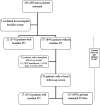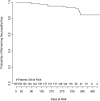Sex differences in the incidence of peripheral neuropathy among Kenyans initiating antiretroviral therapy
- PMID: 21844033
- PMCID: PMC3156141
- DOI: 10.1093/cid/cir432
Sex differences in the incidence of peripheral neuropathy among Kenyans initiating antiretroviral therapy
Abstract
Background: Peripheral neuropathy (PN) is common among patients receiving antiretroviral therapy (ART) in resource-limited settings. We report the incidence of and risk factors for PN among human immunodeficiency virus (HIV)-infected Kenyan adults initiating ART.
Methods: An inception cohort was formed of adults initiating ART. They were screened for PN at baseline and every 3 months for 1 year. We used the validated Brief Peripheral Neuropathy Screen (BPNS) that includes symptoms and signs (vibration perception and ankle reflexes) of PN.
Results: Twenty-two (11%) of 199 patients had PN at baseline screening. One hundred fifty patients without evidence of PN at baseline were followed for a median of 366 days (interquartile range, 351-399). The incidence of PN was 11.9 per 100 person-years (95% confidence interval [CI], 6.9-19.1) and was higher in women than men (17.7 vs 1.9 per 100 person-years; rate ratio, 9.6; 95% CI, 1.27-72, P = .03). In stratified analyses, female sex remained statistically significant after adjustment for each of the following variables: age, CD4 cell count, body mass index, ART regimen, and tuberculosis treatment. Stratifying hemoglobin levels decreased the hazard ratio from 9.6 to 7.40 (P = .05), with higher levels corresponding to a lower risk of PN.
Conclusions: HIV-infected Kenyan women were almost 10 times more likely than men to develop PN in the first year of ART. The risk decreased slightly at higher hemoglobin levels. Preventing or treating anemia in women before ART initiation and implementing BPNS during the first year of ART, the period of highest risk, could ameliorate the risk of PN.
Figures



Similar articles
-
Prevalence of peripheral neuropathy in antiretroviral therapy naïve HIV-positive patients and the impact on treatment outcomes--a retrospective study from a large urban cohort in Johannesburg, South Africa.J Neurovirol. 2012 Jun;18(3):162-71. doi: 10.1007/s13365-012-0093-2. Epub 2012 Apr 20. J Neurovirol. 2012. PMID: 22528477
-
Implementation of a validated peripheral neuropathy screening tool in patients receiving antiretroviral therapy in Mombasa, Kenya.Am J Trop Med Hyg. 2010 Sep;83(3):565-70. doi: 10.4269/ajtmh.2010.09-0629. Am J Trop Med Hyg. 2010. PMID: 20810821 Free PMC article.
-
Peripheral neuropathy in patients with human immunodeficiency viral infection at a tertiary hospital in Ghana.J Neurovirol. 2019 Aug;25(4):464-474. doi: 10.1007/s13365-019-00743-0. Epub 2019 Apr 26. J Neurovirol. 2019. PMID: 31028691 Free PMC article.
-
Increased incidence of symptomatic peripheral neuropathy among adults receiving stavudine- versus zidovudine-based antiretroviral regimens in Kenya.J Neurovirol. 2012 Jun;18(3):200-4. doi: 10.1007/s13365-012-0098-x. Epub 2012 Apr 17. J Neurovirol. 2012. PMID: 22528481 Free PMC article.
-
Prevalence, incidence and predictors of peripheral neuropathy in African adults with HIV infection within the DART trial.AIDS. 2014 Nov 13;28(17):2579-88. doi: 10.1097/QAD.0000000000000447. AIDS. 2014. PMID: 25574960 Clinical Trial.
Cited by
-
Conditional expression of HIV-1 tat in the mouse alters the onset and progression of tonic, inflammatory and neuropathic hypersensitivity in a sex-dependent manner.Eur J Pain. 2020 Sep;24(8):1609-1623. doi: 10.1002/ejp.1618. Epub 2020 Jul 16. Eur J Pain. 2020. PMID: 32533878 Free PMC article.
-
Peripheral neuropathy in HIV patients in sub-Saharan Africa failing first-line therapy and the response to second-line ART in the EARNEST trial.J Neurovirol. 2016 Feb;22(1):104-13. doi: 10.1007/s13365-015-0374-7. Epub 2015 Aug 25. J Neurovirol. 2016. PMID: 26323809 Clinical Trial.
-
Prevalent neuropathy in a cohort of HIV-infected Kenyan sex workers using antiretroviral drugs.Pan Afr Med J. 2016 Sep 20;25:14. doi: 10.11604/pamj.2016.25.14.9699. eCollection 2016. Pan Afr Med J. 2016. PMID: 28154706 Free PMC article.
-
Psychological Factors Associated With Painful Versus Non-Painful HIV-Associated Sensory Neuropathy.AIDS Behav. 2018 May;22(5):1584-1595. doi: 10.1007/s10461-017-1856-9. AIDS Behav. 2018. PMID: 28710709
-
Prevalence of peripheral neuropathy in antiretroviral therapy naïve HIV-positive patients and the impact on treatment outcomes--a retrospective study from a large urban cohort in Johannesburg, South Africa.J Neurovirol. 2012 Jun;18(3):162-71. doi: 10.1007/s13365-012-0093-2. Epub 2012 Apr 20. J Neurovirol. 2012. PMID: 22528477
References
-
- Boulle A, Orrel C, Kaplan R, et al. Substitutions due to antiretroviral toxicity or contraindication in the first 3 years of antiretroviral therapy in a large South African cohort. Antivir Ther. 2007;12:753–60. - PubMed
-
- Forna F, Liechty CA, Solberg P, et al. Clinical toxicity of highly active antiretroviral therapy in a home-based AIDS care program in rural Uganda. J Acquir Immune Defic Syndr. 2007;44:456–62. - PubMed
-
- Hawkins C, Achenbach C, Fryda W, Ngare D, Murphy R. Antiretroviral durability and tolerability in HIV-infected adults living in urban Kenya. J Acquir Immune Defic Syndr. 2007;45:304–10. - PubMed
-
- Millogo A, Lankoande D, Yameogo I, Yameogo AA, Sawadogo AB. Polyneuropathies in patients treated with HAART in Bobo-Dioulasso hospital, Burkina Faso [in French] Bull Soc Pathol Exot. 2008;101:11–3. - PubMed
Publication types
MeSH terms
Substances
Grants and funding
LinkOut - more resources
Full Text Sources
Medical
Research Materials

